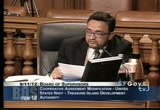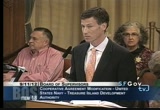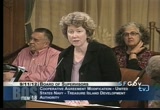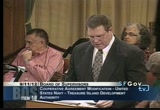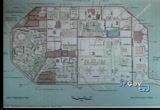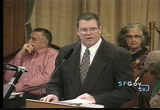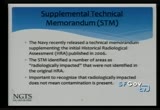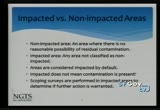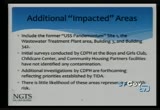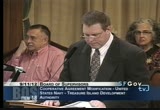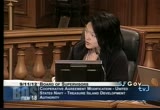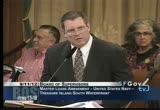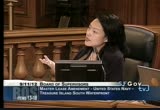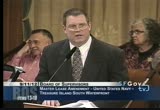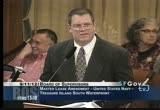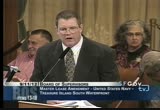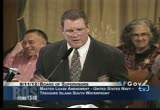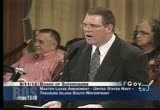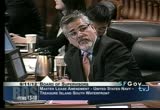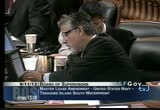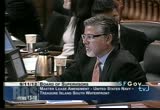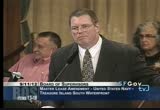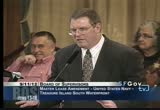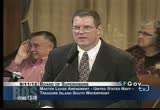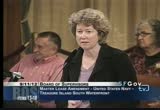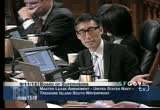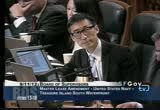tv [untitled] September 12, 2012 5:30am-6:00am PDT
5:30 am
preliminary results, by definition, imply that the results are not final. and what is allowable and what does that mean in terms of the day-to-day health of the residents of the island. thank you. >> good afternoon, president, board members, michael timeoff with the treasure island development authority, project director. i did want to respond to the last question. so as mr. carlan pointed out, tida and puc are engaged in conversations as to the scope and cost associated with the utility repairs in the interim period between today and the development. and we anticipate bringing forward funding solutions and an operating agreement at the same time as we bring back amendments that we have been working on, on the edcmoa, which is the transfer agreement between tida and the navy to confer the property and we anticipate doing
5:31 am
that in the next couple of months. to supervisor campos' question we have a full presentation on the radiological issues so i'd like to turn it back over to amy brownel to address those. >> president chiu, supervisors, my name is amy brownel an environmental engineer with san francisco department of public health. i have 19 years of reviewing navy cleanup. as you're aware the navy has been conducting and is operating the facilities at the -- they're in charge of the facilities at treasure island, and they've been conducting cleanup at treasure island since the mid-1990's under protocols established by the comprehensive response compensation and reliability act. the oversight agency for this work monitoring what the navy is doing is the california department of toxic substances
5:32 am
control. and with respect to radiological protection, the california department of public health oversees that aspect. there are two other regulatory agencies also involved in overseeing all the navy's work and they oversee various aspects of the cleanup. those are the regional water quality control board and the united states environmental protection agency. these agencies review the navy's work plans prior to them conducting the work. they review all the data after the work is done, and verify that it is correct. and they verify that air monitoring and fences and controls are in place when the work is being done. in addition, they also conduct independent scans, which our radiological expert will speak to you about in just a moment. for the past 10 years, amack, environmental and infrastructure has provided independent oversight and review of this navy's cleanup program on behalf of tida.
5:33 am
they also have a consultant who works with them, ngts, and they provide independent review and analysis of the navy's radiological cleanup activities for tida. mr. bob burns is here. he's the chief executive officer of ngts and a certified health fizz sift and he has over 20 years of experience in radiological assessment and will give you a preparation on the rairadiological issues at trease island. >> good afternoon. i know you've all been provided a briefing packet, i believe earlier today. there's a lot of information there, and you may not have had ample time to digest it all at this point. so we have just a few brief slides summarizing the high
5:34 am
points of that presentation. i was going to go over those with you today. as you know, radiological characterization and cleanup operation -- i'm sorry. if we could bring up the powerpoint please. >> president chiu: it's on. >> great. radiological characterization and cleanup activities have been going on at treasure island for roughly six years now. to date, areas of known radiological contamination -- there's only three areas identified with no radiological contamination. we have a map here. i'm not sure... >> excuse me, could you speak directly into the microphone. >> i'm sorry. okay. if we could switch to the overhead, i'm told. there we go. the three areas with known
5:35 am
contamination to date are site 12, the building 233 site, which i can't see because i just changed glasses, building 233 site, and then the site 31, which is in this area here. and that's the extent of known areas of known radiological contamination today at treasure island. it's important to recognize there's extensive oversight by all the navy's cleanup activities there. and through all its oversight activity they have not identified any human health concerns or human health issues at treasure island. likewise, they have consultants to tida based on our independent evaluations and reviews of the documentation, and the investigations performed out there, we have never seen anything that would question or
5:36 am
contradict cdph's conclusions. right back to the powerpoint, the second slide. i'm reminded just today we were provided a letter by cdph, summarizing some of their more recent investigations and i believe you all have been provided a copy of that. as you all know, the navy recently released what it turned as supplemental technical memorandum which is an addendum to the 2006 historical assessment of impacted and non-impacted areas on treasure island. and this supplemental memorandum they identified some - some --
5:37 am
identified some newly identified impacted areas that had not been identified in the previous hra. but in digesting that information it's important to recognize that the radiologically impacted does not mean there is contamination present. so to understand... going back to the letter we received in cdph today we wanted to make it clear that the quote, a direct quote, no health and safety concerns were identified in our surveys in or around the five locations at treasure island. and i'll administer on those additional locations in a moment. going back to the impact versus non-impacted i think that's been a source of a lot of confusion. i wanted to start, the definition of a non-impacted
5:38 am
area, which is simply an area where there is no reasonable possibility of residual contamination. so for a non-impacted area we set a very high bar for being able to -- once an area is deemed non-impacted you're done. you don't do additional investigations, no surveys, no nothing. in general some sites you don't necessarily identify non-impacted areas. often your non-impacted areas are off site used for so-called reference areas for background. what then is an impacted area. an impacted area is an area that you cannot call non-impacted. those areas are impacted by default. impacted does not mean contamination is present. it means the additional scoping surveys are warranted. so some of these additional impacted areas identified in this latest tech memo, if we go back to the overhead, there's
5:39 am
usf pandemonium site one, used by the navy for radiological training exercises and decontamination. wastewater treatment area, building 3, also building 342. too small for me to see. in response to the tech memo coming out, the cdph has gone out and performed some investigations in the vicinity around site 31, around the boys and girls club area, childcare center, community housing partners facilities. they took both direct measurements and what are known as white surveys where you're looking for removable contamination. that's the subject of those surveys documented in the letter we received today.
5:40 am
in addition to those, there are additional investigations that are going to be performed with cdph at the request of tida and using prioritization requested by tida, specifically the sites identified above, papped moneyium site one, wastewater treatment plant area where there's public utilities workers, and also building three and building 342. it's my view there's little likelihood of finding anything of public health concern in these additional areas. >> president chiu: supervisor kim. >> supervisor kim: thank you, mr. burns. thank you for the memo that was brought before us. in the memo you said that you were confident in the data that cdph has provided and measures that they take to assess human health risk and due diligence on the oversight of the radiological program. could you explain why you feel confident in the processes and the measures that cdph takes and
5:41 am
go into a little more detail about what they do. you mentioned surface wipes. to a layperson that doesn't sound very scientific and is not very reassuring. maybe you could talk more about that. >> i would say just looking at everything cdph has done today i think their reactions or responses have been timely and appropriate under the circumstances because you have an ongoing cleanup action as you know, but you also have residents and workers in close proximity. so they've been very proactive and diligent in the actions they've taken, which included so-called direct surveys, where you're making direct measurements of exposure rates in these residential areas, also you mentioned the white surveys. when you talk about surface contamination you can take a detector and take a measurement on the surface and say there's a certain activity level there. in addition you want to know if they're removal activity because
5:42 am
that could present a greater hazard to individuals and would also be indicative, if present, would be indicative of activity that would have been say wind blown or something of that nature. so if it's removal, it's readily dispersible, and it's something that requires a greater degree of care, and also means it's easier to clean up if there. white surveys are another type of assessment that cdph has performed. >> supervisor kim: could you talk about what surface wipes is. are you talking about the ground, the soil? >> no. they're looking, as i understand, i think as windows, window sills, things of that nature, you know, just -- cdph would have to provide more detail but, again, what they're screening for, what they're looking at is was there any wind dispersal or anything of that nature. >> supervisor kim: i'm sure you understand the concerns that our residents have. >> crm. >> supervisor kim: particularly the cield care
5:43 am
center and boys and girls club because that was listed by the navy as a potential site. you've made it clear just because it's radiologically impacted doesn't mean there's actual contamination present but it also does not mean there isn't contamination present. >> that is correct. >> supervisor kim: so the early assessments of cdph that these sites are safe for use by our children and families, i hope you can go into more detail as to why that is the case. i personally have concerns. i understand why our residents have concerns given that this is what we're presenting to them. so kind of speak to that. >> okay. again, i can't go -- i can't speak on behalf of cdph, i can't go into great detail about their measurements, other than my outside review, i guess, or just looking at the work that they've done, like i said, everything -- i don't see anything that -- they did everything -- i would do, whatever that's worth. like i said, their measures were
5:44 am
timely and appropriate, and they're going to continue to perform investigations in these newly identified areas. and the residents will be informed of that information as soon as it's available. like i said we got the letter from cdph today, which i... >> supervisor kim: i do want to give my colleagues an opportunity to ask questions because there are some. in your work experience, have you ever had suffers wipes collected, that have shown that the sites are safe, but then after further investigation, that you found that there was contamination on site that was hazardous to the health of workers and residents? >> okay. well, let's ask the resident question first. i've never been involved with a cleanup project where we've had material get off site, where it was any sort of -- of any concern to residents or were identified contamination off site. you have to recognize the difference between measurements and assessment you're making
5:45 am
within the work sites which are geared toward the cleanup actions versus the types of measurement that cdph is doing which are geared toward assessing public health. so i mean can you find -- you know -- >> supervisor kim: why don't we -- when i meant workers i meant people work on the island, not workers involved in cleanup activity. we have folks that work at the boys and girls club, the child center, we have families on site as well. for us as elected officials, as san francisco residents that we speak to what can we do to assure them given the sample swipes have shown that there aren't contamination on site currently. but my question is, is that have there been cases in the past where that has been the preliminary conclusion but then with further surveying work that we have found contamination on site that is hazardous to the health of our residents -- not our residents, residents in other sites? >> understood.
5:46 am
i was saying in general. my general answer would be no, but it's important that these measurements and assessments are -- they need to be done periodically. >> supervisor kim: my next question, and this wasn't in your memo but was in our city attorney's memo, was that -- some of the potential sites that additional scoping surveys would not be conducted until 2013. and my question is why so late? >> i can't speak to that. i'm not involved with the scheduling. but i know as far as the priorities that tida has requested of cdph regarding these newly identified areas, the focus is areas where there are occupied residences, and areas where there are puc workers. >> supervisor kim: have you read some of the media articles that have come out lately? >> not all, but some, yes. >> supervisor kim: what would be your response to some of the
5:47 am
concerns from previous residents of treasure island that say that they feel like there's a higher rate of cancer amongst their family, and their neighbors, and some of the concerns that have come up through those articles? >> i'm not aware of an elevated cancer rate. as far as that being -- but i'm also not aware of any radiological exposure of anyone on treasure island that -- of that background, of a -- you know, distinguishable from background and that's what cdph and -- have said all along. again, i'm not aware of any elevated cancer rate but i wouldn't think you could draw any correlation, if there was such a thing, i can't see drawing a correlation to elevated radiation when there wasn't been any. radiation is a fact of life we're exposed to it every day, it's a natural thing, it's nothing to be afraid of. >> supervisor kim: would you feel comfortable with your kids being at the boys and girls club? is. >> yes. given the -- i have two children.
5:48 am
my kids are 5 and 3. they're my whole world. >> supervisor kim: i do want to give opportunity to my colleagues to ask some questions as well. >> president chiu: supervisor avalos. >> supervisor avalos: thank you, supervisor kim. thank you for your questioning. i think they're real good questions you were asking. i'm not going to belabor the point, but there is a forthcoming report from cdph that's coming out, correct? is i'm expecting it t to be -- they're doing ongoing work now based on the latest data that's come out. you reference it here in your talking points. you say there's -- cdph's investigation to date have identified any public health dangers. there is little likelihood of significant public health risk with regard to the impacted areas. you say the same thing again earlier in your talking points. so do you feel that the work
5:49 am
that cdph is doing is redundant? how is it different from what you've already accomplished, but you can still say that -- how is their investigation different from what you have already accomplished? how could you say that i'm not going to come up with any health risk? >> i'm not sure what you mean about what i've already accomplished. my role has been review and oversight. as far as what do i mean when i say -- i think there's little likelihood. that's twofold. one, i don't think there's fewer possibility of finding any contamination in these newly identified areas. i don't think that there would be significant contamination found in those areas. given that, you know, there's been work going on at treasure island for some time and that the known radiological areas, areas which would most likely contain the most contamination have been deemed not to present a health risk, then i think by logical extension i just don't
5:50 am
see it as being a high probability, even if there is any activity identified in these newly impacted areas, newly identified impacted areas. >> supervisor avalos: cdph are they doing any other kind of assessment done by -- >> i don't do assessments, i strictly -- 16r78g9s but you do oversight. >> i review what the navy contractors are doing, what cdph is doing. i have not performed any independent assessment. >> supervisor avalos: who could talk about that? >> either -- well, cdph would have to talk about their work, and... >> supervisor avalos: so last weekend, the east bay express, they talked about radium wells, talked about disks that were found in different places, in some of the areas that have had -- where there's radiation that's been potential contamination of radiation. can you talk about those -- that
5:51 am
were found. >> the foils and disc are commodities as they're called out there. they're deck markers, they're radio loom nes sent devices used back in the day like i said for marking decks on the ships. they're used for marking gauges, marking ditches. they're used today they're just not radium. where those commodities have been identified are these solid waste disposal areas. >> supervisor avalos: where there have been known -- you talk about it as known areas of radiological contamination, in those areas they were found? >> correct. 12 primarily was my understanding. >> supervisor avalos: we're going to have a hearing on the whole thing later on. so i will be cosponsoring that, and will go into further
5:52 am
discussion. >> president chiu: supervisor campos. >> supervisor campos: thank you. i know the items before us involve a master lease, and a cooperative agreement. but i do think it's important in the context of the siting whether or not to support those items to have a better sense of the safety issues that have been raised. i think -- i know that there's going to be a public hearing on this, which i think is a great idea. and i want to thank supervisor kim, supervisor avalos, for sponsoring that. what worries me about this is the fact that, as you said, you know, there is no guarantee that that in fact there is no contamination that could create a health hazard. i mean i think your presentation is a carefully drafted document that, you know, leaves open the very possibility that there could be health implications here. isn't that correct? >> that's correct, recognizing
5:53 am
there's these additional investigations that cdph is still going to be conducting. i don't want to be me mature. and i believe in, you know, never say never. >> supervisor campos: and that's the question. i mean so i do have a question about the wording though. in your report, it says that there is a little likelihood of these areas representing a health risk. in terms of definition of likelihood, what is that definition? i mean what percentage, what... >> it would be difficult to quantitative. again, me being a scientist, that's how we speak. we don't look at things in black and white but in continuum of probability and such. so when i say little likelihood again i can't assign a probability to it but certainly no more so than -- like i say i think what we already know out there is the low-hanging fruit. i don't see these additional areas, you know, for whatever
5:54 am
quantification you want to assign to what we've encountered and assessed out there, i don't see these additional areas presenting any risk, certainly not any greater than that. >> supervisor campos: would likelihood be like 40%? is that lower? >> lower. >> supervisor campos: 20? >> if you're going to hold me to a number, we're talking about likelihood of a public health risk? i would say probably less than five. if that. >> supervisor campos: so less than five. i think that's the question for us is at what point do we feel comfortable enough to reach the point that we feel like we've done everything. i still wouldn't want to be less than 5%, you know, that have 5% or 4% likelihood that we're wrong. so -- >> well you've got to bear in mind, you've got to look at radiological risk or any
5:55 am
individual risk in context with the overall spectrum of risk that we're all exposed to just from being alive. again, radiation is a natural thing. we're all exposed -- the average american gets 620 milligram a year of background radiation. >> supervisor campos: if that's the case then you certainly want to vote areas where there is even more radiation than is usually allowed, right? i mean that cuts different ways. >> again we're talking about levels that is so small i don't think we're encroaching on allowable levels at all. >> supervisor campos: let me ask you this way. so there is this supplemental technical memen memorandum thatd there are new areas that are rage lodically impacted -- radiologically impacted. legally under federal law or state law, are there limitations in terms of what kind of developments can go into a radiologically impacted area? >> in my limited experience, and i'm not a lawyer and not a real
5:56 am
estate expert but usually those are deed restrictions that can be -- my bad. >> again, amy brownel from the san francisco health department. all of these areas that were identified in that supplemental technical memorandum are navy areas that navy is going to investigate. they are doing their work, and investigating them. there is not going to be any development until the navy has finished all their investigation, and then all of the regulatory agencies have signed off that everything has been done correctly. during the investigation phase, the navy will control the area, have fences, do air monitoring. the cdph and the other regulatory agencies will verify that they're doing that. there is no chance of contamination going outside of the area, that the navy will control during their work. and then when it is all done, and signed off, and cdph will give a free release letter that
5:57 am
says all the work is done, there is no contamination left, everything is same as background, basically. that's called a free release. only at that point would the property then transfer, and be used by tida and developed. there will be no development until the navy has signed off on all the radiological issues. >> supervisor campos: well i appreciate all the work and i think that it's good to just follow up on these issues through the additional hearing. i'm still concerned. i think a 95% likelihood that we are right about no health implications is pretty good but i don't think it's good enough. so hopefully we'll get to 100% at some point. thank you. >> president chiu: supervisor mar. >> supervisor mar: thanks, ms. brownel, mr. burns for the presentations. i wanted to say if i were one of the parents of the child development center i think supervisor kim was raising this questioning, mr. burns, whether he would have his kids in a spot
5:58 am
that we weren't absolutely 100% sure was going to be safe would make me nervous, given some of the press reports. and then i know in 2003, and the department of public health is aware of this that we passed our cautionary principle policy that states where threats of serious or irreversible damage to people or nature exists lack of full scientific certificateity about the cause and effect shall not be viewed as sufficient reason for the city to prevent the degradation of the environment or protect the health of its citizens. i really worry that of the 2,000 residents that live on the island, that some of the key kind of new potential sites are very close to many of the residences. and the boys and girls club, and many areas where young children, who might be even more susceptible live. but i just wanted it know, could you give us more certainty that the sites are going to be safe. because i would be worrying if i were one of those parents or one
5:59 am
of those kids. >> thank you, supervisor mar. again, mr. burns was talking about the areas and how the investigation was going to happen, and the question was asked about his certainty on those issues. again, that's for the areas that the navy is going to investigate, the residents do not live there, and they're not going to be allowed to live there. there will not be any development there. those areas will be properly investigated. the -- as we already mentioned, and is in your letter that you received from california department of health -- public health, the boys and girls club, the childcare center, the school, the winery, and the trailer, were all scanned by cdph and have been cleared, that there is no public health risk, based on their scans that they have already done. there are other areas that -- as mr. burns was mentioning, are going to be investigate by cdph. in fact i'm aware that they went out there today to start that, and to do their scans. so all of those areasa
70 Views
IN COLLECTIONS
SFGTV: San Francisco Government Television Television Archive
Television Archive  Television Archive News Search Service
Television Archive News Search Service 
Uploaded by TV Archive on

 Live Music Archive
Live Music Archive Librivox Free Audio
Librivox Free Audio Metropolitan Museum
Metropolitan Museum Cleveland Museum of Art
Cleveland Museum of Art Internet Arcade
Internet Arcade Console Living Room
Console Living Room Books to Borrow
Books to Borrow Open Library
Open Library TV News
TV News Understanding 9/11
Understanding 9/11